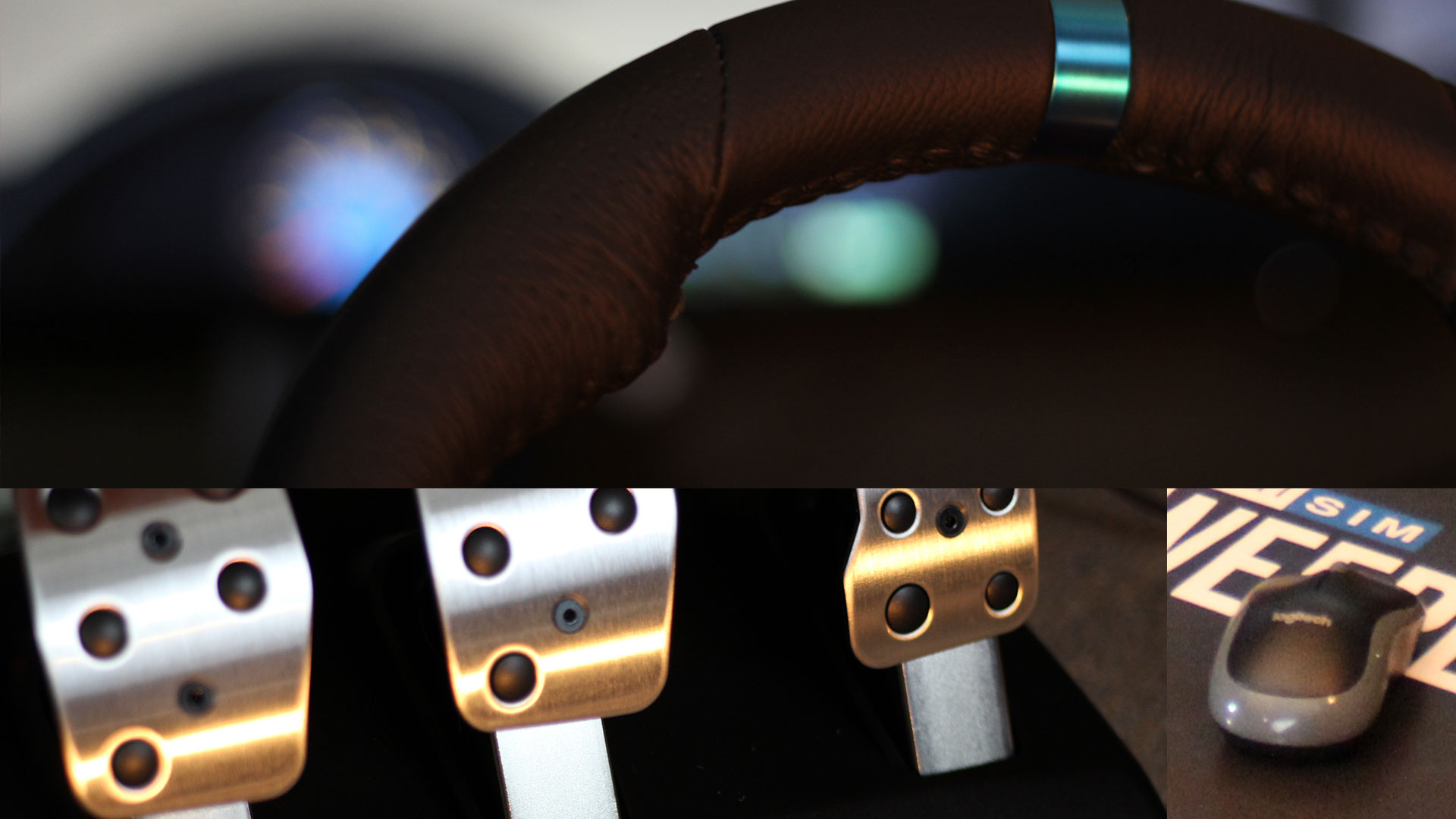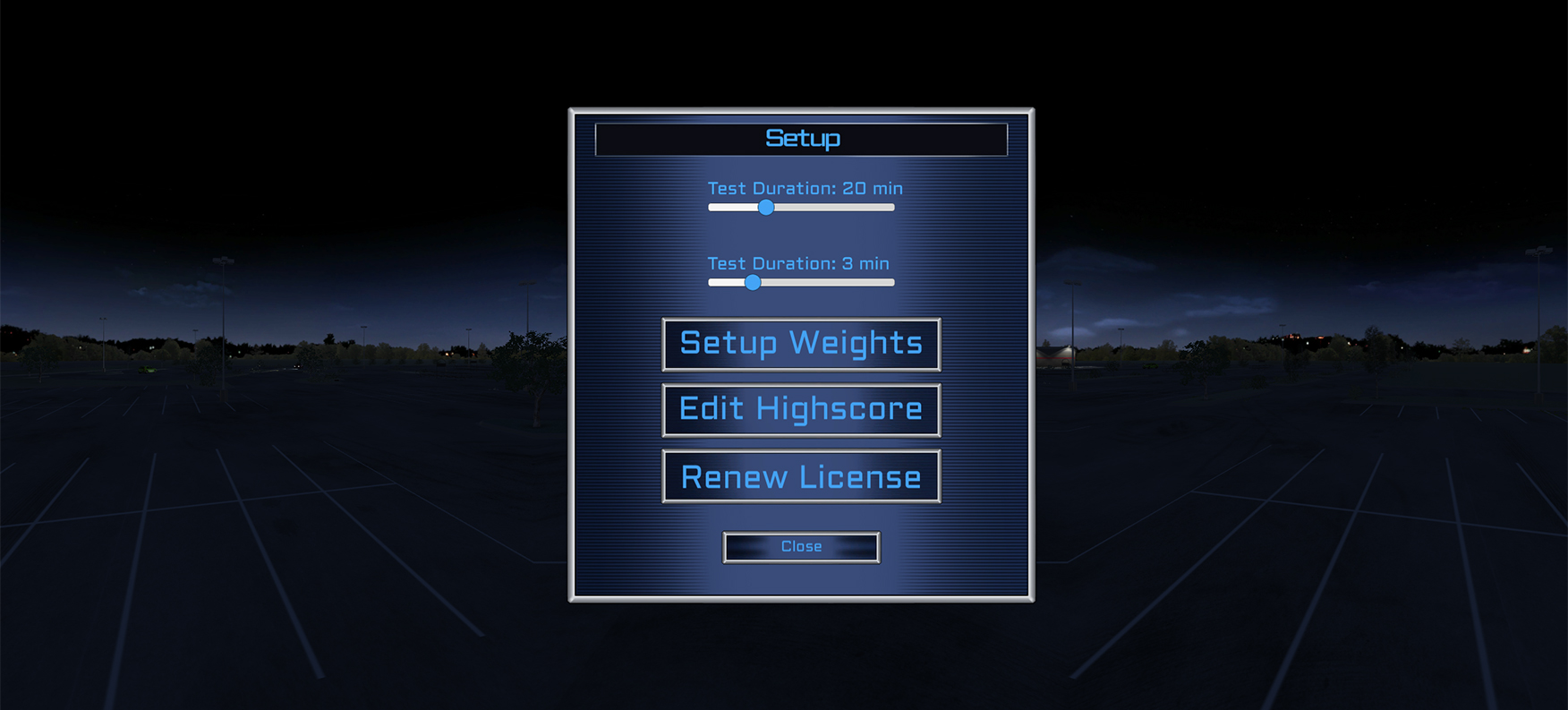The Virtual Training Advantage
How SweeperSIM™ Works
Sweeper operator trainees are scored against a trainer-created or pre-existing template which is considered the ‘ideal’ performance model. If a trainee hits a major obstacle during a training simulator session, the test immediately stops, and a FAIL notice requiring the trainee to restart their session from the beginning appears. After all, it is better for a driver to damage a virtual sweeper, than a sweeper truck costing $90,000 to replace. At the end of each training session, the path taken is fully reviewed and compared to the template, with scoring emphasis on minimizing right hand turns, proper speed, minimal overall turns, hand picking items, percent of debris collected verses missed, and time to complete.

SweeperSIM™ features a panoramic view from the driver’s seat. An overhead diagram of the parking lot and property is also displayed along with live visual recording of the session statistics.
The experience is enhanced with realistic sounds paired with interactions in the simulator environment such as the sound of broken glass and other debris being sucked up into the hopper and even the sound of the broom when it is engaged.
- The simulator operator has controls that mimic a typical sweeping truck. The operator can also control the speed of the truck and stop it if, for example, they need to “exit” and move an obstacle such as a shopping cart or “pick up” debris that can’t be picked up by a sweeper (this is done with a mouse click on the screen). Clicking also simulates hand picking, which is part of the work required on the simulated property.
As the operator “sweeps” the parking lot, SweeperSIM™ tracks the driver’s performance. It monitors time on the parking lot, turns, right-hand turns and the percentage of debris picked up. The simulated debris field has been carefully constructed with input from experts in the sweeping business to test even the most experienced drivers as they hone their skills and qualify new drivers.


- The more debris you collect, the shorter your time on the route, the fewer turns and fewer right-hand turns you make; the higher the score. in the event of a collision with a wall, sign, speed bump, curb or parked car – the simulator session ends and is scored accordingly.
- SweeperSIM™ will help qualify new prospective employees and clearly demonstrate the responsibility requirements of the job, serving as a screening process. Qualified prospects will be trained to section off areas, to finish an area before moving on, and even make them aware of areas that require hand picking. It will also teach and reinforce proper parking lot best practice sweeping habits, such as approaching a speed bump squarely, rather than at an angle and minimizing gutter broom usage when sweeping wide open areas.

Once a participant has completed sweeping the parking lot, the system will tally their points and mistakes and generate a score based on weighted parameters set by the instructor. This final tally not only tells owners if a prospect is ready to operate their equipment and do the job, it lets the prospect know where they stand and how well they did – before they ever gets behind the wheel of expensive equipment or expose their company to real world liability or damages.

-
SweeperSIM™ is designed to help trainees develop the mental discipline to work efficiently in the middle of the night with the field of view provided by headlights. It takes practice to get used to sweeping a parking lot looking through headlights, so this gives new driver trainees a good idea of what the job will looks like at night.
You can also design SweeperSIM™ contests for current employees, posting best scores for other operators to beat, encouraging operators to improve their skills by challenging their co-workers.
How SweeperSIM Works
Sweeper operator trainees are scored against a trainer-created or pre-existing template which is considered the ‘ideal’ performance model. If a trainee hits a major obstacle during a training simulator session, the test immediately stops, and a FAIL notice requiring the trainee to restart their session from the beginning appears. After all, it is better for a driver to damage a virtual sweeper, than a sweeper truck costing $90,000 to replace. At the end of each training session, the path taken is fully reviewed and compared to the template, with scoring emphasis on minimizing right hand turns, proper speed, minimal overall turns, hand picking items, percent of debris collected verses missed, and time to complete.

SweeperSIM features a panoramic view from the driver’s seat. An overhead diagram of the parking lot and property is also displayed along with live visual recording of the session statistics.
The experience is enhanced with realistic sounds paired with interactions in the simulator environment such as the sound of broken glass and other debris being sucked up into the hopper and even the sound of the broom when it is engaged.
The simulator operator has controls that mimic a typical sweeping truck. The operator can also control the speed of the truck and stop it if, for example, they need to “exit” and move an obstacle such as a shopping cart or “pick up” debris that can’t be picked up by a sweeper (this is done with a mouse click on the screen). Clicking also simulates hand picking, which is part of the work required on the simulated property.

As the operator “sweeps” the parking lot, SweeperSIM tracks the driver’s performance. It monitors time on the parking lot, turns, right-hand turns and the percentage of debris picked up. The simulated debris field has been carefully constructed with input from experts in the sweeping business to test even the most experienced drivers as they hone their skills and qualify new drivers.
The more debris you collect, the shorter your time on the route, the fewer turns and fewer right-hand turns you make; the higher the score. in the event of a collision with a wall, sign, speed bump, curb or parked car – the simulator session ends and is scored accordingly.

SweeperSIM will help qualify new prospective employees and clearly demonstrate the responsibility requirements of the job, serving as a screening process. Qualified prospects will be trained to section off areas, to finish an area before moving on, and even make them aware of areas that require hand picking. It will also teach and reinforce proper parking lot best practice sweeping habits, such as approaching a speed bump squarely, rather than at an angle and minimizing gutter broom usage when sweeping wide open areas.
Once a participant has completed sweeping the parking lot, the system will tally their points and mistakes and generate a score based on weighted parameters set by the instructor. This final tally not only tells owners if a prospect is ready to operate their equipment and do the job, it lets the prospect know where they stand and how well they did – before they ever gets behind the wheel of expensive equipment or expose their company to real world liability or damages.

SweeperSIM is designed to help trainees develop the mental discipline to work efficiently in the middle of the night with the field of view provided by headlights. It takes practice to get used to sweeping a parking lot looking through headlights, so this gives new driver trainees a good idea of what the job will looks like at night.
You can also design SweeperSIM contests for current employees, posting best scores for other operators to beat, encouraging operators to improve their skills by challenging their co-workers.

Once a participant has completed sweeping the parking lot, the system will tally their points and mistakes and generate a score based on weighted parameters set by the instructor. This final tally not only tells owners if a prospect is ready to operate their equipment and do the job, it lets the prospect know where they stand and how well they did – before they ever gets behind the wheel of expensive equipment or expose their company to real world liability or damages.

Option One
*Recommended Experience
MONITORS:
(3) Monitors – 27″ widescreen LCD with DisplayPort/HDMI or DVI support – desktop only
COMPUTER:
Processor – dual core 2.4 GHz+
(i7 series Intel processor or equivalent AMD)
RAM – 8 GB
Hard Drive – 256 GB or larger solid state hard drive
Graphics Card – For 3 monitor setup NVIDIA® GeForce® GTX 1080 or equivalent
Operating System – Windows 10 or 8.1
STEERING CONTROLS:
Logitech G29 Racing Steering Wheel
Logitech 3-pedal

Option Two
*Minimum Requirement
MONITOR:
(1) Monitor – 24″ widescreen LCD with DisplayPort/HDMI or DVI support
COMPUTER:
Processor – 6th Generation Intel® Core™ i5 processor
(i5 series Intel processor or equivalent AMD)
RAM – 8 GB
Hard Drive – 128 GB or larger solid state hard drive
Graphics Card- NVIDIA GeForce 730 2GB or equivalent
Operating System – Windows 10 or 8.1
STEERING CONTROLS:
Logitech G29 Racing Steering Wheel
Logitech 3-pedal

Option One
*Recommended Experience
MONITORS:
(3) Monitors – 27″ widescreen LCD with DisplayPort/HDMI or DVI support – desktop only
COMPUTER:
Processor – dual core 2.4 GHz+
(i7 series Intel processor or equivalent AMD)
RAM – 8 GB
Hard Drive – 256 GB or larger solid state hard drive
Graphics Card – For 3 monitor setup NVIDIA® GeForce® GTX 1080 or equivalent
Operating System – Windows 10 or 8.1
STEERING CONTROLS:
Logitech G29 Racing Steering Wheel
Logitech 3-pedal

Option Two
*Minimum Requirement
MONITOR:
(1) Monitor – 24″ widescreen LCD with DisplayPort/HDMI or DVI support
COMPUTER:
Processor – 6th Generation Intel® Core™ i5 processor
(i5 series Intel processor or equivalent AMD)
RAM – 8 GB
Hard Drive – 128 GB or larger solid state hard drive
Graphics Card- NVIDIA GeForce 730 2GB or equivalent
Operating System – Windows 10 or 8.1
STEERING CONTROLS:
Logitech G29 Racing Steering Wheel
Logitech 3-pedal
Features
- Conditions
Dusk/Dawn/Darkness
Icy/Wet
Pavement/good to poor integrity
Lighting/none to reflective
Various debris patterns/light to heavy
Seasonal foliage/fall leaves & spring seeds/etc.
- Obstacles
Light poles/bollards
Speed bumps
Potholes
Manhole covers
Parked vehicles
Islands & corners
Unsweepable debris/sticks/large boxes/etc.
Large Items/Illegal dumping/tires/couches/etc.
-
Challenge
Broken glass/missed debris/etc
Working only with vehicle headlights, Head interaction
Best Practices
Sweeper Head Awareness
Visual solution from non-driver view
Gutter Broom Usage
Visual solution from non-driver view
Backing Up (Reverse) Awareness
Pick head up; visualize through windshield while backing up
Beacon Usage
Vehicle marker lighting; exterior warning lights for safety
Sweeping Speed
Ideal driver practices vs. actual driver simulator results
Zamboni-style pattern
Left turns only for driver’s side visibility; practice universal turn to not overwork machine
Sectioning strategy & procedures
Perimeter sweep & inspection with driver’s side window down
Future Development
We continue to develop SweeperSIM™ in a variety of ways. For example, in the future, weather conditions and other versions of parking lots will be added to enhance the training experience through a variety of scenarios.
We offer customization services of SweeperSIM™ such as control panel modifications, specific manufacturer vehicles or for any custom sweeping location environment.
Contact Digital Image Studios about this product.

